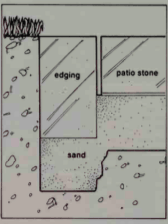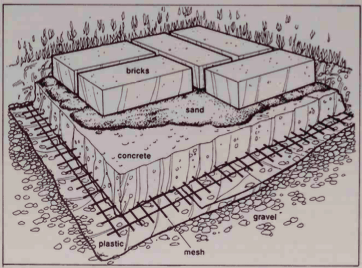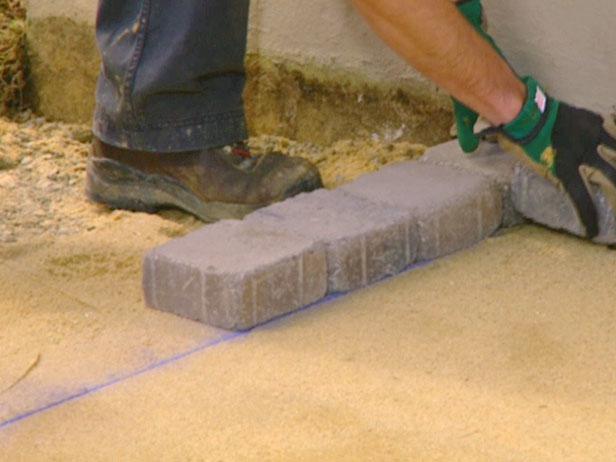Building a Patio
Garden seating areas can be formal with mortared joints, or informal with the bricks or stones resting on sand.
Patios are individual. They are designed to suit the needs of the user. They can be built close to the house for dining and entertaining. They can be built in the middle of the yard, surrounded by plants and shrubs for a relaxing conversation area. They can be small for intimate seating or large to handle a party. And they can be made from a variety of materials: brick, smooth concrete, textured concrete, stones, blocks, precast concrete tiles ana even ceramic tiles.
Mortarless paving
One of the easiest types of patios to build is the mortarless paver patio. Bricks, precast concrete tiles and stones can be used for this type of patio. The paving stones are set on a bed of crushed limestone, which restricts weed growth and allows for proper drainage.
To build a mortarless patio, outline the perimeter of your area by driving stakes into the ground and joining the stakes with string. Dig the patio area to a depth of 12cm (5in) plus the thickness of the paver you’ll be using. To allow for drainage, the patio should slope away from the house 3 to 6mm (1/8 to 1/4in) for every 30cm (1ft). Should your patio not be located near the house, make the center of your patio the highest point and slope all sides away from the center. Place roofing felt on the area to inhibit plant growth. Overlap the seams by 15cm (6in).
You’ll need to add an edging around your patio to prevent shifting of the pavers. Use treated wood or, if using brick, turn the bricks on end and bury them in a trench the perimeter of the patio. Make sure the top of the wood or brick edging will be flush with the surface of your patio.
Next add a 10cm (4in) layer of gravel covered with a 25mm (1 in) layer of small stone screenings. Level the fill and compact it with a power compacter. These machines can be rented from most rental shops.
Cover the screenings with at least a 25mm (1in) layer of sand. Dampen the sand with spray from a garden hose.
Lay your bricks or stones in the chosen pattern, placing the pavers close together. You’ll inevitably need to cut some of the pavers to fit the patio area. Cutters can be rented from rental shops to make light work of this task.
Once the bricks have been laid, they need
to be compacted to provide a firm structure. Again, use the power compacter for this task, since the tighter the fit the greater the stability of the patio.
The last step is to sweep sand into all the small cracks between the pavers to fill the gaps and to provide extra support. Hose the patio clean and it’s ready for use.
A word of caution: should you use clay bricks for your patio pavers, don’t use limestone screenings for the base. The salts from the limestone will migrate through the brick, creating a discoloring and haze on the surface of the brick.
Pavers with mortar
A more formal look to your patio can be created by again using pavers, but this time setting the pavers in mortar to provide a smooth, strong surface.
If you live in a cold climate where the ground freezes and thaws, creating the potential for ground heaving, you’ll need to provide a firm concrete base, with good drainage underneath, for your patio. Should you live in a milder climate, you can follow the same method as for the mortarless paving.
To create a patio in cold climates, you’ll need to dig your patio area deep enough to allow for a 10cm (4in) concrete base and a 15cm (6in) layer of gravel underneath the concrete.
Dig your excavation, fasten a permanent or temporary edging around the perimeter, and apply a 15cm (6in) layer of crushed stone. Level the stone and pack it down firmly Remember to pitch the surface for drainage. Place polyethylene sheeting over the stone, overlapping the seams of the sheeting by 15cm (6in). The plastic prevents moisture from seeping into the concrete. Next, apply wire reinforcement mesh. This welded wire mesh reinforces the 10cm (4in) concrete layer that is poured directly on the mesh. Strike the concrete surface level. Use a flat 2 x 4 to strike off the concrete, moving the board back and forth as you advance. Let the concrete cure for several days.
Dry-lay your stones onto the concrete, starting in one corner. Leave about 6mm (1/4 in) of space between the stone for the mortar. Make any necessary cuts, then remove a small section of stone and start applying mortar. Apply a layer of mortar (2 parts sand to 1 part cement), lay your stones and tamp them level. Once they’re level, fill the joints with mortar and smooth with a jointing tool.
If you’re not using a concrete slab base, apply a 50mm (2in) layer of sand to the gravel base, lay your stones, then tamp each stone into place, making sure it’s level. Once the stones have been levelled, apply a dry mortar mixture of 4 parts sand and 1 part cement to the gaps between the stones. Use the edge of a board to tamp down the mortar, pressing firmly to ensure a good fill. Sweep the stones carefully then wet the surface with a fine spray keeping the area damp for 2 to 3 hours. Tool the joints. Once the mortar has hardened, rub off the excess from the stones using a stiff brush. Then, using a wet sponge, clean each stone, being careful not to touch the mortar.
When laying a brick patio with mortar, it’s best to butter the edges of each brick with wet mortar as you lay them. Then shove the brick toward the previous one laid, leaving a distance of 6 to 12mm (1/4 to 1/2 in) between bricks. Make sure you butter the edges with enough mortar to fill the gap. Keep laying the bricks, but after about an hour go back and tool the joints. Remember that mortar starts to set in about two hours. You can slice off the mortar to leave a flush joint or you can draw a dowel along the mortar to make a concave joint.
Mortar stains on the brick can be removed with a mixture of 10 parts water to 1 part muriatic acid. Scrub the acid solution over the brick with a stiff brush. Wear rubber gloves, goggles and old clothes to protect yourself against acid burns. Don’t use muriatic acid on stone patios; the acid could stain the stones.
PATIO BORDER

To keep the bricks on your mortarless patio from shifting, you’ll need to install a border or edging. You can use wood or a row of bricks placed on end. Dig a trench about 15cm (6m) wide to allow for the width of the brick plus a 5cm (2 m) layer of sand. Make sure edging is flush with the top of the patio.
PATIO FOUNDATION

For a stone or brick patio to be durable, care must be taken in building the foundation. In cold climates, you’Il need to add a concrete base to prevent heaving. Dig deep enough to allow for a layer of gravel on a firm soil base, plastic, concrete, sand and bricks.
